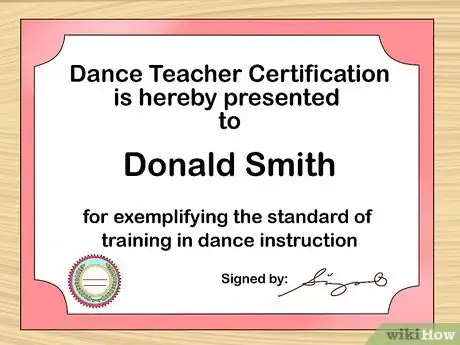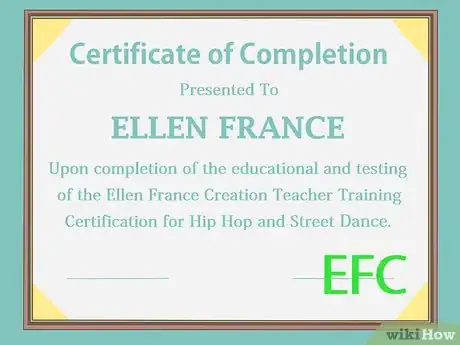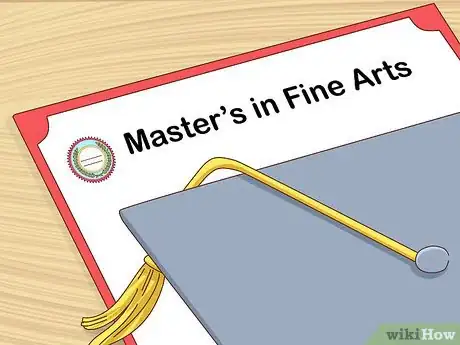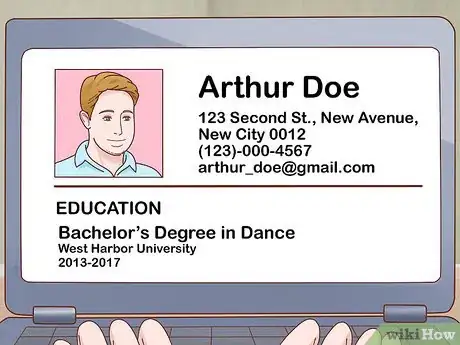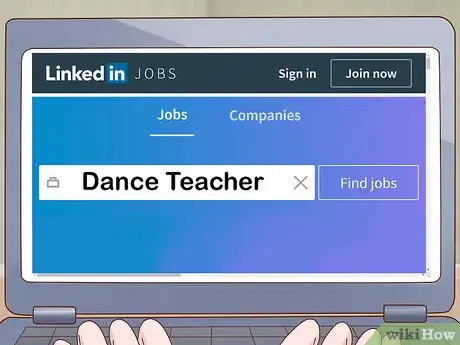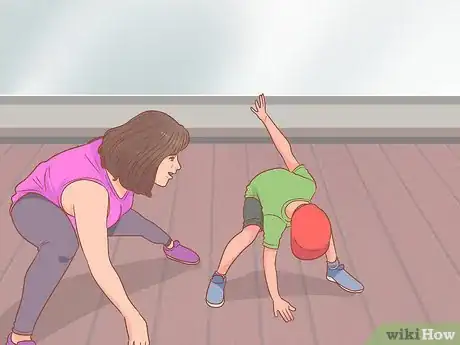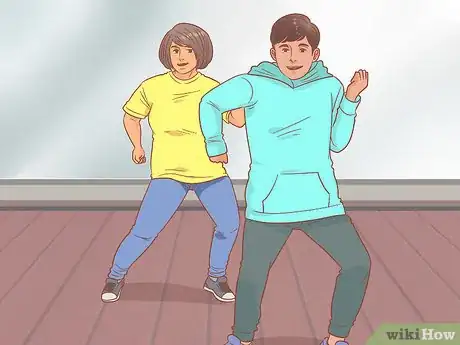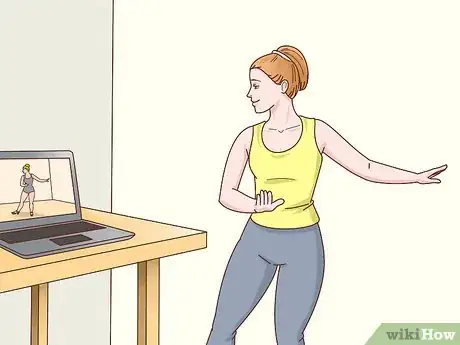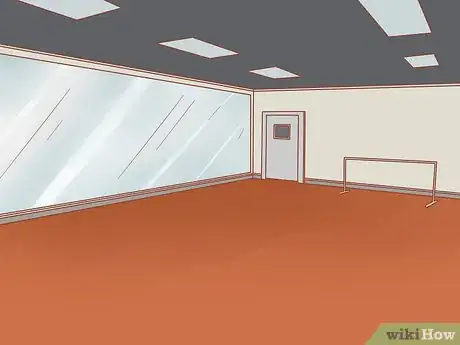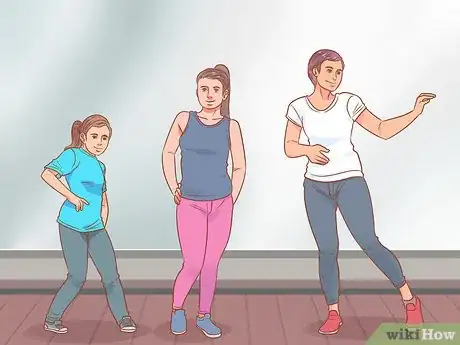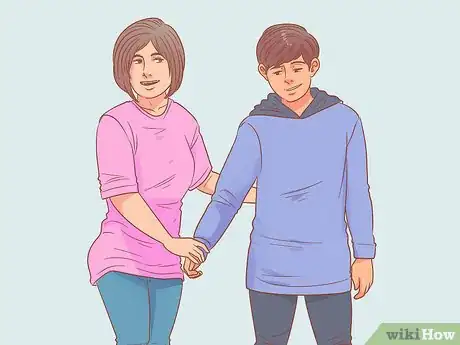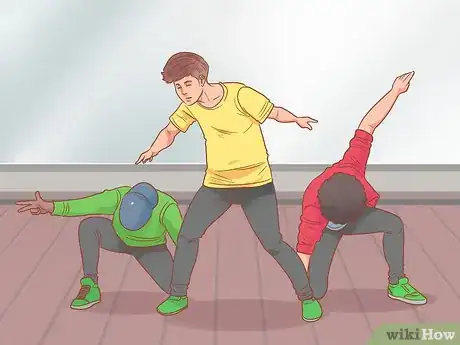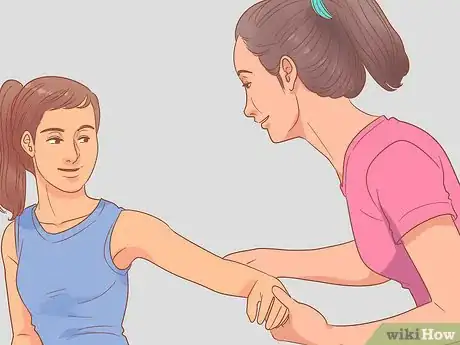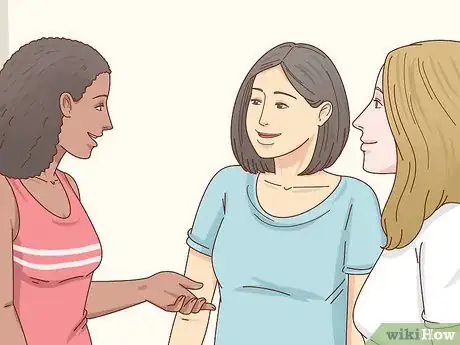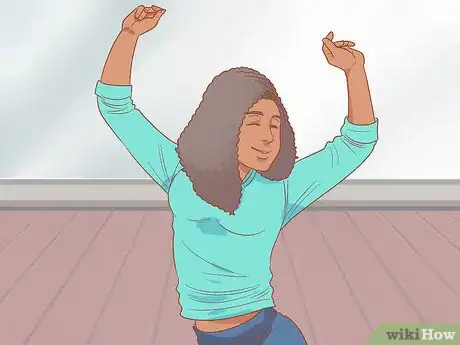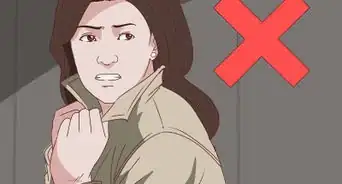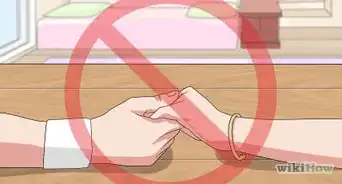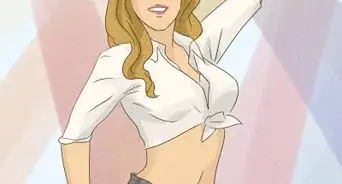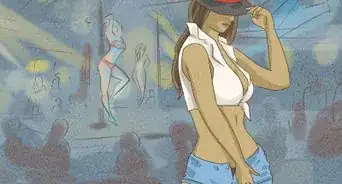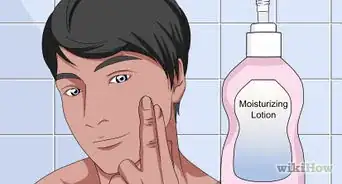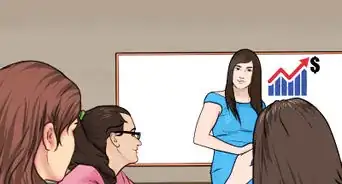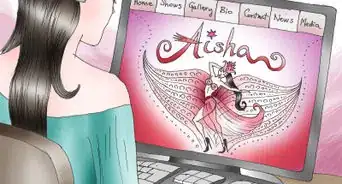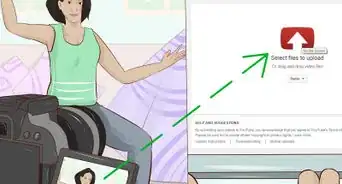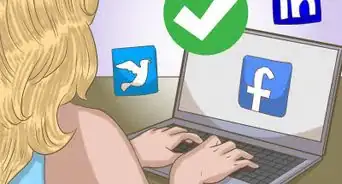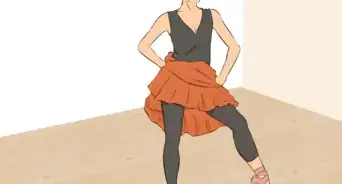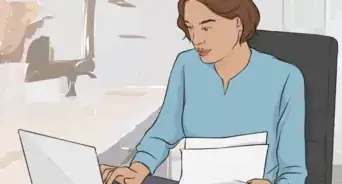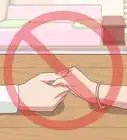This article was co-authored by Val Cunningham and by wikiHow staff writer, Amy Bobinger. Val Cunningham is a Choreographer, Lead Dance Instructor, and Certified Yoga Instructor at The Dance Loft, a dance studio based in San Francisco, California. Val has over 23 years of dance instruction, performance, and choreography experience and specializes in ballroom, Latin, and swing dancing. She is also trained in house, hip-hop, jazz, ballet, and modern dance, and has studied with world renouned dancers such as Tom Slaterand Richard Lambarty. She is ISTD (Imperial Society of Teachers of Dancing), ProDVIDA (Professional Dance Vision International Dance Association), and Zumba certified. She is a member of the National Dance Council of America.
There are 9 references cited in this article, which can be found at the bottom of the page.
This article has been viewed 40,874 times.
If you love dancing, becoming a dance teacher can be a fun and rewarding way to turn your passion into a career. Dance is a highly competitive industry, so becoming a dance teacher can take a lot of dedication. First, you’ll need dance training in your favorite genre. Then, pursue the certification required by the organization or school where you’d like to teach. If you’re passionate and you work hard, you can succeed!
Steps
Earning Your Credentials
-
1Start by training as a dancer. You can't teach what you don't understand, so find a genre you love and work hard to learn it. Take dance classes and private lessons, and consider participating in competitions, performances, and dance intensives to constantly improve your skills.[1] In addition, dancing is physically demanding, so take good care of your body by eating well, practicing proper form with an instructor, and knowing when to rest.[2]
- It can take years of training before you're ready to teach others. Many professional dancers start dancing as young children, although some don't take their first lesson until much later.
- Try out a few different dance styles to see what you like. Some of the most popular genres of dance include: ballet, tap, ballroom, jazz, hip-hop, liturgical, and modern dance.[3]
- Go on auditions if you want to dance with a production, like as a back-up dancer for a musician or a stage show. This will also help you network, which could help you later in your career.
-
2Complete your high school diploma or GED. You’ll need at least a high school diploma if you want to work as a dance teacher. Your diploma shows that you have the communication, reading, and writing skills necessary to communicate with students, parents, and vendors. If you’ve already left school, you may be able to get a certificate that is the equivalent of your diploma, known as the GED, or General Educational Development.[4]
- Some teaching positions will require you to complete more education.
Advertisement -
3Pursue a dance teacher certification to teach at a private studio. Many individually-owned studios have their own requirements for teachers. If there’s a dance studio near you where you’d like to teach, contact the owner and ask them what certification you would need to work there. They may offer a certificate program through the school, or they may have you become certified through an independent organization.[5]
- Some studios will have more stringent requirements than others. In some cases, the studio may only want you to demonstrate your dance experience, especially if you’re applying for a part-time or assistant position, or if it’s a non-competitive local dance studio.
- In the UK, you will most likely need a specialized qualification from the Council for Dance Education and Training.[6]
- In the US, programs vary. Some popular dance teacher certification groups are the Royal Academy of Dance, the American Ballet Theatre, the National Dance Teachers Association of America, and the American Tap Dance Foundation.[7]
-
4Earn a fitness certification if you want to teach dance at a gym. Teaching dance classes at a gym is a great way to help others learn about fitness while expressing their creativity. These classes are growing in popularity, and they’re fun way help children, seniors, and everyone in between be healthy and active.[8]
- Popular dance fitness programs include Zumba, Barre, and Jazzercise.[9]
-
5Pursue a bachelor’s degree in dance for advanced opportunities. If you want to teach in a public school or some of the more competitive dance studios, you’ll need to complete a dance program at a college or university. There are a number of schools that offer degrees in dance, although you can also major in performing arts or even your preferred genre of dance if you can find a school that offers a program.[10]
- It will likely be easier to find a school offering programs specific to classic styles of dance, like ballet, than more modern styles like hip hop. However, a general dance or performing arts degree will typically be sufficient if there isn’t a program for your dance style.[11]
-
6Become licensed in your state if you want to teach in public schools. After you earn your bachelor’s degree, you’ll need to get a teaching license if you want to teach dance to public school students. The requirements for being licensed typically vary based on where you live, so check with the Department of Education or similar institution for your school system.[12]
- These certifications are typically based on the grade level you want to teach, whether that’s elementary or primary school students, middle or junior high, and high school.
- You may not need a teaching license to work at a private dance school.[13]
- Depending on where you go to school, you may be able to become certified through your college program. Check with your school’s career counseling department for more information.
-
7Earn an MFA or PhD in dance education for the most prestigious jobs. If you want to work somewhere like a university or a dance conservatory, or if you want to work as a coach for professional dancers, you’ll need at least a graduate degree in dance, although for some positions, a doctorate in dance might be required. These degrees can take years to achieve and the programs can be difficult, but you’ll have a prestigious education when you’re finished.[14]
- These programs will cover dance techniques, choreography, kinesiology, dance history, and more.[15]
- Your master’s degree can be in performing arts, fine arts, dance education, or a specific genre like ballet. You will likely work as a student teacher during the program, which will provide you with valuable educational experience.
- Typically, a PhD is centered on dance education.
Finding a Teaching Job
-
1Put together a dance resume. Just like any other resume, a dance resume should highlight all of your relevant skills and experience, along with a few references. However, you should also include where you trained, what choreographers or companies you’ve worked with, and any industry-related awards or standout roles you earned.[16]
- Remember to put your contact information at the top of the page so the employer can contact you if you’re chosen for the position!
- Keep your resume short—it should only take up one side of one sheet of paper. If you have more experience than you can fit on one sheet, focus on the experience that’s most recent and most relevant to the position you want.
-
2Work as an assistant or co-choreographer if you want an entry-level job. It can sometimes be hard to find your dream job when you’re first starting out, because many positions are listed for someone who already has experience as a dance teacher. A great way to earn the experience you need is to find a position working under another dance professional.[17] For instance, many studios keep assistant teachers on staff to help the primary instructor by working one-on-one with students.
- You also might choreograph routines, lead beginner-level classes, and help with administrative duties.
- If you don’t want to teach at a studio, try to find a choreographer or dance teacher in your area who is looking for a personal assistant. For instance, if you want to teach liturgical dance, you might reach out to local churches to see if there are any worship leaders who could use help.
-
3Apply for full-time jobs at local dance studios, schools, and community organizations. To find full-time work, look for dance openings on job forums and in classified ads. You can also ask your dance connections—don’t underestimate the potential of word-of-mouth opportunities! When you find an opening, send your dance resume along with a cover letter explaining why you’d be a good fit for the position.
- Focus on studios and organizations that teach your preferred style of dance, if possible. For instance, if you dance hip-hop, you would apply at studios that teach modern dance, while if you are a ballet dancer, you might choose studios that focus on classic dance styles. Some studios will cover multiple dance styles, so do a little research to find out what they’re most proficient in.
- Depending on the size of the dance community where you live, you might need to consider relocating for opportunities.
-
4Find a part-time teaching job if you need flexible hours. If you already have another job, or if you don’t want to work full-time, consider working part-time instead. You might teach a few after-school classes every week, for instance, or you might teach private lessons on the weekends. That way, you can still enjoy sharing your passion for dance without committing to a full-time career.[18]
- You can even do seasonal work. For instance, you might work a few weeks out of the year teaching at summer camps, festivals, or workshops. This can be great if you prefer a less popular style of dance, like interpretive dance or a cultural dance that doesn’t have the audience for year-round classes.
-
5Teach private lessons if you enjoy working one-on-one with students. Private lessons are a great way to help another dancer take their craft to the next level. You’ll be able to give them personalized advice, correcting their form and technique on the spot instead of after a big group session.
- You can advertise online or by word-of-mouth to find students who want to take lessons. You may also find private lesson opportunities through a dance studio.[19]
-
6Grow a following on social media if you're comfortable with technology. Social media allows you to network, publish videos, and you can even offer online lessons. To build a following, post consistently, offer helpful dance tips, and offer behind-the-scenes looks at the dance industry.
- YouTube and Instagram are both good platforms for building an online following.
- Follow other dancers and dance teachers in your dance genre to help you grow your following. You can even follow musicians. For instance, if you’re a hip-hop dancer, you might follow hip-hop artists, rappers, and producers to get an idea for what’s going on in the industry.
-
7Open your own dance studio if you want to work for yourself. Once you’ve worked as a teacher for a few years, you might decide you want to own your own business. Write out a detailed business plan, find a location for your studio, and use your dance connections to find students.
- If you open your own studio, chances are it will be your turn to give up-and-coming dance teachers a shot!
Being a Good Dance Teacher
-
1Decide what age group you're most comfortable with. While some dance teachers work with a variety of ages, from young children to seniors, many teachers choose to focus on a specific age group. There are different challenges for different ages, so by specializing, you’ll be able to hone your teaching style to be most effective for the group you want to work with.
- For instance, you might work with children starting from the age of 3 until they’re about 10-12, you might choose to teach teens from ages to 13-18, or you might prefer holding classes for adults ages 19 and up.
-
2Offer your students constructive criticism. It can be hard to let someone know when they’re doing something wrong, but it’s essential as a teacher. You’ll need to be comfortable correcting your students’ form, and it will be up to you to encourage them when they need to work a little harder. However, remember to build them up by praising them when they do a good job, and try to keep your classes fun.[20]
- Dance is very competitive, so you'll have to push your students if they want to be successful.[21]
- Having good form is an important part of avoiding injuries, so it’s crucial that you be able to critique your students.
-
3Come up with creative choreography. When you’re creating a dance routine, like for a recital or a competition, try to think of fun and innovative ways to sync the dancers’ movements with the music. Use the dance to show off your own style and personality, as well as the skill of your dancers.[22]
- Many choreographers prefer to listen to a piece of music over and over, then create a dance routine that goes along with the rhythm, harmonies, and emotion of the song.
- Consider incorporating elements from different genres into your dance. For instance, a few jazz moves can liven up a ballroom routine, while a ballet spin can add grace to a hip-hop routine.
-
4Mentor your students on and off the dance floor. As a dance teacher, you and your students will often have to spend a lot of time together. Sometimes, you might need to be there for a student who's going through things outside of class, especially if you teach private lessons or small classes. If you notice that a student is having a hard time concentrating or they seem heavy-hearted, consider having them stay an extra minute or two after class in case they want to talk about it.
- Of course, as a teacher you have to be able to separate yourself from your students’ problems, too. Be there as a listening ear, and offer thoughtful advice, but keep in mind that you can’t always solve the issue.
-
5Be prepared for dance parents if you’re teaching young students. Since dance is a very competitive environment, dance parents tend to be very motivated and passionate. They want the best for their children, which can sometimes lead to heightened emotions if they have strong opinions that conflict with your teaching methods.
- Keep in mind that the parents of your students are usually well-intentioned, and try to keep a pleasant yet authoritative tone when you’re speaking with them.[23]
-
6Remember why you got into this career. As you work to become a dance teacher, there may be times when you feel frustrated, overwhelmed, or underappreciated. The dance world can sometimes be a high-pressure environment. However, if this is what you're really passionate about it, stick with it and work hard, and it will be worth it.[24]
Expert Q&A
Did you know you can get expert answers for this article?
Unlock expert answers by supporting wikiHow
-
QuestionIs it hard to become a dance teacher?
 Val CunninghamVal Cunningham is a Choreographer, Lead Dance Instructor, and Certified Yoga Instructor at The Dance Loft, a dance studio based in San Francisco, California. Val has over 23 years of dance instruction, performance, and choreography experience and specializes in ballroom, Latin, and swing dancing. She is also trained in house, hip-hop, jazz, ballet, and modern dance, and has studied with world renouned dancers such as Tom Slaterand Richard Lambarty. She is ISTD (Imperial Society of Teachers of Dancing), ProDVIDA (Professional Dance Vision International Dance Association), and Zumba certified. She is a member of the National Dance Council of America.
Val CunninghamVal Cunningham is a Choreographer, Lead Dance Instructor, and Certified Yoga Instructor at The Dance Loft, a dance studio based in San Francisco, California. Val has over 23 years of dance instruction, performance, and choreography experience and specializes in ballroom, Latin, and swing dancing. She is also trained in house, hip-hop, jazz, ballet, and modern dance, and has studied with world renouned dancers such as Tom Slaterand Richard Lambarty. She is ISTD (Imperial Society of Teachers of Dancing), ProDVIDA (Professional Dance Vision International Dance Association), and Zumba certified. She is a member of the National Dance Council of America.
Certified Dance & Yoga Instructor
-
QuestionHow can I connect with my dance students?
 Val CunninghamVal Cunningham is a Choreographer, Lead Dance Instructor, and Certified Yoga Instructor at The Dance Loft, a dance studio based in San Francisco, California. Val has over 23 years of dance instruction, performance, and choreography experience and specializes in ballroom, Latin, and swing dancing. She is also trained in house, hip-hop, jazz, ballet, and modern dance, and has studied with world renouned dancers such as Tom Slaterand Richard Lambarty. She is ISTD (Imperial Society of Teachers of Dancing), ProDVIDA (Professional Dance Vision International Dance Association), and Zumba certified. She is a member of the National Dance Council of America.
Val CunninghamVal Cunningham is a Choreographer, Lead Dance Instructor, and Certified Yoga Instructor at The Dance Loft, a dance studio based in San Francisco, California. Val has over 23 years of dance instruction, performance, and choreography experience and specializes in ballroom, Latin, and swing dancing. She is also trained in house, hip-hop, jazz, ballet, and modern dance, and has studied with world renouned dancers such as Tom Slaterand Richard Lambarty. She is ISTD (Imperial Society of Teachers of Dancing), ProDVIDA (Professional Dance Vision International Dance Association), and Zumba certified. She is a member of the National Dance Council of America.
Certified Dance & Yoga Instructor Try to joke with your students and remain humble. Teach with heart and remind your students that you know what it is like to make mistakes. Let them know that you are human and that even 20 years later, for example, you can still mess up choreography sometimes. Everyone has the opportunity or the need to practice something many times.
Try to joke with your students and remain humble. Teach with heart and remind your students that you know what it is like to make mistakes. Let them know that you are human and that even 20 years later, for example, you can still mess up choreography sometimes. Everyone has the opportunity or the need to practice something many times. -
QuestionCan I be a self-taught dance teacher or do I have to go to actual classes?
 LuminatTop AnswererThat depends on how good you are at dancing, and where you live. In most places, you need a certification to teach dance, and to gain a certification, you normally have to participate in several dance classes and examinations.
LuminatTop AnswererThat depends on how good you are at dancing, and where you live. In most places, you need a certification to teach dance, and to gain a certification, you normally have to participate in several dance classes and examinations.
References
- ↑ Val Cunningham. Certified Dance & Yoga Instructor. Expert Interview. 6 February 2020.
- ↑ https://learn.org/articles/How_Do_I_Become_a_Dance_Teacher.html
- ↑ https://learn.org/articles/How_Do_I_Become_a_Dance_Teacher.html
- ↑ https://education.seattlepi.com/education-needed-dance-teachers-1391.html
- ↑ https://education.seattlepi.com/education-needed-dance-teachers-1391.html
- ↑ https://nationalcareersservice.direct.gov.uk/job-profiles/dance-teacher
- ↑ https://dance.lovetoknow.com/Dance_Teacher_Training
- ↑ https://www.nyfa.edu/student-resources/how-to-become-a-dance-teacher/
- ↑ https://vivaglammagazine.com/6-dance-fitness-classes-you-should-try/
- ↑ https://learn.org/articles/How_Do_I_Become_a_Dance_Teacher.html
- ↑ https://education.seattlepi.com/education-needed-dance-teachers-1391.html
- ↑ https://www.nyfa.edu/student-resources/how-to-become-a-dance-teacher/
- ↑ https://education.seattlepi.com/education-needed-dance-teachers-1391.html
- ↑ https://education.seattlepi.com/education-needed-dance-teachers-1391.html
- ↑ https://www.nyfa.edu/student-resources/how-to-become-a-dance-teacher/
- ↑ https://www.pointemagazine.com/dance-resume-how-to-2541920413.html
- ↑ Val Cunningham. Certified Dance & Yoga Instructor. Expert Interview. 6 February 2020.
- ↑ https://www.nyfa.edu/student-resources/how-to-become-a-dance-teacher/
- ↑ Val Cunningham. Certified Dance & Yoga Instructor. Expert Interview. 6 February 2020.
- ↑ https://www.nyfa.edu/student-resources/how-to-become-a-dance-teacher/
- ↑ Val Cunningham. Certified Dance & Yoga Instructor. Expert Interview. 6 February 2020.
- ↑ https://www.nyfa.edu/student-resources/how-to-become-a-dance-teacher/
- ↑ https://www.danceadvantage.net/dance-teacher-ups-and-downs/
- ↑ https://www.danceadvantage.net/dance-teacher-ups-and-downs/



